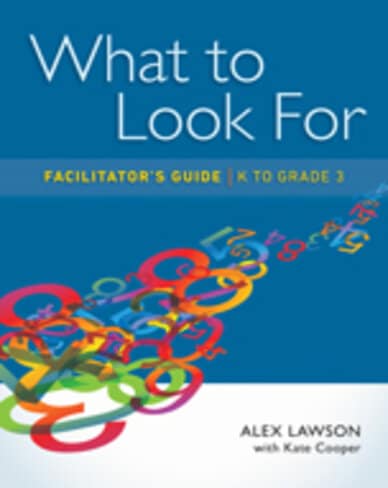
Imprint
Pearson Canada
Author(s)
Alex Lawson, Kate Cooper
Focusing on What to Look For and the development of early numeracy, this print and digital resource has been field-tested in a range of school districts. It’s innovative approach to professional learning supports school- and district-based math coaches in two ways: by providing additional background information on What to Look For and by providing scaffolding to coaches who want to enhance their facilitation sessions.
Included in this comprehensive resource are:
- modifiable facilitation scripts and slide decks
- student and facilitation videos
- facilitation tips and notes
- coaching notes
When you purchase this resource, you will receive:
- a coil-bound print copy of the facilitator’s guide;
- a digital version of the facilitator’s guide and
- access to a comprehensive website that includes all of the digital material you will need to facilitate a session
Facilitator Guide and Course Book also available
Modal
What to Look For Facilitator’s Course for School and District Math Leaders
Course Description
This course is designed for those math coaches, consultants and administrators who want to dig deeper into the facilitator’s guide and extend their learning. Working on two levels, deepening math knowledge and providing facilitation support, this highly interactive learning session will equip you with the tools you need to lead learning in your school or district and use the facilitator’s guide to its full extent.
Course Highlights
- Construct the continuum of mathematical development and use of math strategies for addition and subtraction, K-3.
- Learn about facilitation moves that support deep learning and effective implementation.
- Analyze videos of student thinking to learn to identify strategies and understand key ideas.
- Learn about effective instructional practices (the use of models, word problems, activities, games and number talks) that support the development of student thinking.
- Experience joyful and positive mathematics learning.
Course Outcomes
- Develop a stronger understanding of how young children learn to add and subtract.
- Experience facilitation moves that support deep educator learning and effective implementation.
- Reflect on learning environments that engage and extend educators’ and students’ mathematical thinking.
Audience: Administrators, school and district math leaders
Delivery Method: On site
Course Fee: $5000, includes copy of What to Look For Facilitator’s Guide and Course Book (max 45 participants).
ISBN: 9780136640448
Net Price: $5000.00



